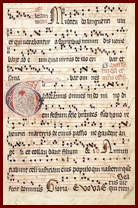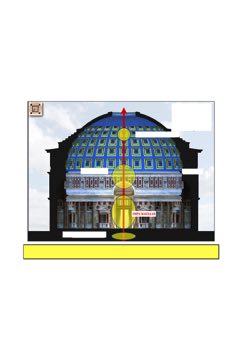_________________________________________________________________________________________
For more about me, click on the image
The Pantheon
Rarely, a building impressed and inspired so many people as the Pantheon in Rome. Being probably the best preserved temple of Roman Empire, it needs a bit more than just a quick visit.
The old Rome was divided in three big blocks: One was for the politics (the Forum Romanum), a second was for the religion (with the Pantheon in its centre, surrounded by many other temples: Neptune, Isis, Minerva ...) and the last part was for conspiracy (Circus, theater, public baths a.s.o.).
The name
The word Pantheon is a contraction of two greek words: “Pan” is the abbreviation of “Panorama”, an overview; and “Theon” derives from “Theology”, the gods. But who were all the gods for which was build the Pantheon by the emperor Hadrian between 118-125 AD?
In mythology there is a variety of Gods ... We have the Greek mythology where on the Olympus, Zeus is ruling over the others, than the gods of the Roman Republic and finally, also emperors became God. How can we divide this magnitude of gods? Quite simple ! Have you ever seen in the seventies the soap-serial Dallas on television?
If not, don’t worry! They just made a remake of it. The success of that serial was that it was a perfect imitation of the Greek mythology. The adultery behavior of the number one of the family (Zeus/ J.R. Ewing), created jalousie, rivals, his wife Sue Ellen started drinking, his brother Bobby ran away and every episode, a total unknown bastard-child felt out of the closet. Nonetheless, JR Ewing is trying to keep the family together in between all those intrigues. Rereading the greek mythology, it’s all about that: jalousie, rivals, murder and intrigues among the gods on the Olympus.
The Romans in the Republican era didn’t had a message on those gods: they were farmers and their early gods reflected the virtues of nature: Apollo (the Light), Minerva (wisdom), Mars (war), Isis (fertility) a.s.o. The earlier Pantheon was build in the middle of the Campo Marzo, and dedicated to those gods.
And then it happened that Julius Caesar was in bed with Cleopatra. She was the last heir of the family Ptolomeo, she was the last pharaoh of Egypt. And as a pharaoh, she was also the goddess of fertility. With her came the whole lifestyle from Egypt to Rome, and made that the emperors after Julius Caesar were becoming Gods. For those gods was build the Pantheon as we know it today.

Legends
From the Pincio-hill and the Quirinal-hill, two little rivers are coming down in the valley of the Campo Marzo. They are crossing each other exactly in the middle of the Pantheon, about 5 yards under the paving. After that they disappear in the earth. In the paving there are 22 holes for conducting the incoming water to the rivers. For the earlier Romans, that was impossible: the pantheon is located in the lowest part of the city, and that two rivers are disappearing in the ground, underneath the river the Tiber, seemed for them impossible. The legend told us that Romulus, the founder of the city, at the end of his terrestrial lifespan, was token to heaven on the crossroad of the two rivers. And a rectangular temple was build. Probably a very simple one in wood, and the entrance was on the opposite site of today.
A second temple on the same site was build in 28 AC, by the son in law of the emperor Augustus: Nonetheless that Hadrian rebuild it after the fire of 79, it still bears the inscription of the son in law: M.AGRIPPA F.L. COS. TERTIUM FECIT: Marcus Agrippa Filius Luci (son of Lucius) cos. Tertium (consul for the third time), fecit (made it).
What we have today was built in only seven years under the emperor Hadrian, during the years 118-125 AD. His first name was Helios, the greek word for the sun. And what he built is probably the most perfect sun-temple ever built. Inca’s, Maya’s and other cultures have built their sun-temple, but rarely achieved the perfection of the Pantheon.
It starts with the entrance gate to the north. Twice a year we have the solstice in the building: On the 21st of december through the door, and on the 21st June through the oculus (the open hole in the middle). If you turn the dome around, you would create a sphere on the millimeter. So, the romans had a notion that the earth is round. Entering the building we count seven chapels, like we have seven days in the week. Above them we have 12 niches, representing the twelve months of the year (the so called Julian Calendar: 10 months became 12 months like today), and in the dome we have 28 square blocks in a row, a reminder of the 28 days in one moon-cycle. The colors in the marble decoration are reflecting the constellation of the stars. The building must have been magnificent: outside it was said that it was covered with guild bronze, unfortunately token away by my relatives, the barbarians. The dome inside covered with normal bronze; this token away together with the bronze statues of the emperors by Constantinople.
The building is an achievement in construction:
Foundation: 24’ thick at base and steps to 21’ at ground level
Rotunda: concrete, 20’ thick; 142’ diameter
Oculus: concrete: 7.5’ thick; 27’ diameter
Interior Columns: 3’ diameter, 29’ tall topped with a corinthian capital
of 4’ totaling 32’ 9" tall, 25 tons each
Portico: 16 granite columns 39’ tall, 5’ diameter, 60 tons each
In my article about Roman inventions we are going deeper in on one of the greatest invention of the Romans in architectural history concrete.
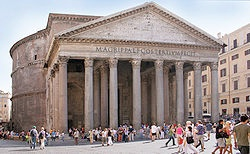
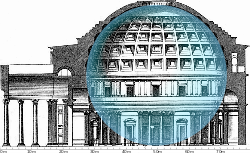
History
Build between 118-125 AD as a pagan temple by the emperor Hadrian, he got the critic of his architect Appolodorus, who thought it looked very much like a pumpkin. In 476 AD, and in the years after the collapse of Rome, the barbarians took the guild bronze from the outside. In 609, the last emperor of Constantinople, Foca, came in official visit to Rome. From pope Gregory IV, he was allowed to build (on his own behalf of course) a memorial column on the Forum Romanum. It would become the last add to the Forum. In return the Pope received the Pantheon, and could transfer the original use of a pagan temple in the first converted basilica. And because the victor is writing history, from that day it was preserved from further looting. There is a beautiful painting of this act at chapel that leads you to the sacristy. The Pope received also a sacred image of Mary, from which the tradition tells us that it was made by the hand of the gospel-writer st. Luc. It is the icon in the absis. Today the original is kept in the sacristy and replaced by a copy. Note of the author: If all icons attributed to st. Luc (who was also a doctor), are from his hands, he would never found the time to write the gospel!
It was not because the emperor Phocas was agree to give the Pantheon to the Pope, that the local population of Rome was happy. Their temple dedicated to all the gods would become a Roman Catholic Church. Since 313 by the edict of Milan, christianity was recognized among the other religions in Rome. Since 380 under pope Damasus it became the official religion of the Roman empire. But it was not that it was now official that the Romans didn’t venerated their old gods anymore. Oh no!! They would have put their betts on all of them, Jesus as well as the pagan gods. In matters of believe, you can’t take risks. And when they heard that their temple became a Roman Catholic basilica, they protested.
But also the church knew how to handle this problem. From the catacombs, outside the city and that they couldn’t protect anymore with the small population after the decline of the Roman Empire in 476 AD, they decided to remove the remains of paleochristian saints within the city-walls. Saint Cecilia found her last burial place in her basilica in Trastevere, while over 40 000 remains were removed and reburied under the altar of the Pantheon.
How smart of the Church: a temple called Pan-theon (all the Gods), became a basilica called Pan-(t)Aghion (all the Saints).
Even the inauguration day was a perfect match of the Church: it happened on the 13 Mai, 609 AD. And was that by mere accident exactly the day that the Church celebrated the ascension to heaven of Jesus Christ? You remember the legend how Romulus was taken to heaven from the crossroad of the two rivers underneath the Pantheon? But from Jesus they made a big statue in papier-maché, and took him out of the building by the open hole, the oculus in the middle.
A little music note: the famous gregorian chant (click on image for listening)”Locus Iste” (<<full text) - This is the place, was created for the ceremony of the day that the Pantheon became Roman Catholic Church. It is still in use for the consecration of new churches all over the roman catholic world.
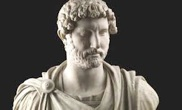

And history went on. On the night of Christmas of the year 800, Charlemagne
was coroneted as first emperor of the Holly Roman Empire in the old st. Peters’ Basilica in Rome. To celebrate that event, without offending the Germans, the Gauls, the italian and all the others of his empire, they decide to celebrate it in the Pantheon. Didn’t we have all the Saints being buried there? The day chosen was the 1st of November 811. All Saints-day was born !!
A legend told us that the night before in the Pantheon was celebrated the first All Saints day, the bronze doors (and they are still of the original bronze) were closed. A kind of an earthquake shook the building and the narrative is that in that night the last pagan spirits left the building for ever and ever: Halloween was born !!! And didn’t Apollodorus, the beloved architect of Hadrian said that the building looked like a pumpkin? Here is exactly what Cassius Dio said about: “When Trajan was consulting him on some point about the buildings he had said to Hadrian, who had interrupted with some remark: “Be off, and draw your pumpkins. You don’t understand any of these matters.” When Hadrian became emperor, therefore, he remembered this slight and would not endure the man’s freedom of speech.”
I believe that our tradition of making pumpkins with holes in it to release the evil spirits, is going back to the Pantheon. A tradition that st. Patrick took to Ireland, and from there it conquered the world.
But history went on. In 1520 died in Rome one of the most celebrated painters of all time: Raphael Sanctis di Urbino. His premature death at the age of 36 convulsed the Romans, and on his own wish he got buried in the Pantheon. Today he is buried in a roman sarcophagus in the third chapel on the left from the entrance. Recently, pilgrims of the books of Dan Brown (Angels & Demons) come to visit his tomb. It was the first chapter of the book, but unfortunately Robert Langdon was always one step behind the murders. In the niche, on the left side of the Madonna with child (made after his design) is a bronze bust of Raphael. On the right side should have arrived a bust of his girlfriend Maria Bibiana, he intended to marry. Being much occupied in his short lifetime mostly with other women (among them the famous Fornarina), he didn’t see her so often during lifetime, and even after his dead, she never joined him. And so we remained with an empty niche on the right. Today Raphael is buried in that roman sarcophagus on which cardinal Bembo wrote a beautiful text: “Ille hic est Raphael. timuit quo sospite vince rerum magna parens, et moriente mori”: “"Here lies Raphael, by whom nature herself feared to be outdone while he lived, and when he died, feared that she herself would die."
A lovely complement for indeed a fabulous painter. Indeed, Mother Nature can hardly surpass the colors and compositions of Raphael.
From the day Raphael was buried in the Pantheon, the Pope installed in the Pantheon a “Confraternità dei Virtuosi”, were worldwide artists who did something in art for the Roman Catholic Church, can become member of. Until today. Every five years the Holy Father nominates new members. As result, in the Pantheon are also buried the musician Arcangelo Corelli, the painter Hannibale Caracci and many others. Most of them are buried in the first chapel to the left from the entrance, a chapel dedicated to st. Joseph.
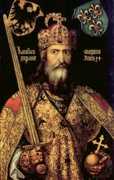


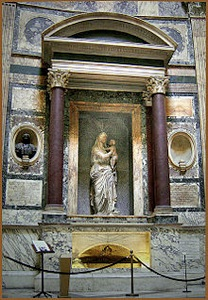

The Fornarina by Raphael
A little story of myself and a friend ...
For many years, I am member of the german speaking Roman Catholic association of Academics: “Capitolina im CV” in Rom.
One of the founding fathers of the Roman branch was Card. Joseph Ratzinger, the future pope Benedict XVI, speaking today, Pope Emeritus. Yearly we celebrate our Dies Natalis (foundation day), which always included a pontifical high mass in the Pantheon. It happened on one of those occasions that I guided the guests who came from all over the world to celebrate with us, through the Pantheon. Because it’s a movement of academics, the students are the heads and among the members, no titles are allowed, only their christian name. And so we got to the chapel of st. Joseph. My obvious question was to cardinal Joseph Ratzinger if he knew for whom st. Joseph is the saint patron. The answer was there and ready: he is the patron for carpenters and Roman catholic craftsmen and Roman Catholic Unions. I replied that we should look at the chapel and see what we can find in the gospels about st. Joseph.
It all started nine months before the birth of Jesus. An angel announced the immaculate birth of Jesus and told Mary that her aunty Elisabeth was pregnant. In the meanwhile Joseph had a dream: not to fear to take Mary as his wife, even if she was not pregnant of his son. When he woke up, Mary came to him and told him the news. He replied: I know it already, I’ve got a dream. No scandal, I take you as my wife. “Oh yeh”, she said, “and I heard that my aunty is pregnant. Are you coming with me to visit?” “Oh no!, I am to tired, go alone and give her my greetings!”, was his reply.
Nine months later, after a difficult journey to Bethlehem, finally they arrived. They taught they could stay in a hotel (maybe Giulio Cesare hotel), but unfortunately, everything was overbooked. As you know, it was high season, Christmas time. But Joseph was so tired that he said: “No matter wherever, as long you can find a spot to sleep, I need a rest.” And so Mary and Joseph finished in a cave. He felt immediately asleep and during his sleep, Mary went through labour and gave birth to a child. Shepherds came to visit her and also three Kings of the east, bringing gifts to the newborn King: gold, incense and myrrh.
Meanwhile, Joseph got a dream. An Angel warned him to leave Bethlehem as soon as possible, not taking the same route to avoid king Herod who wanted to kill the child.
When he woke up, Mary came to him and showed him the Newborn.
“Ai”, he said, “we have to escape, let’s go to Egypt .... but we have no money left !” “No problem”, replied Mary, “three Kings came to visit us during your sleep and left gold behind”.
So they went to Egypt. That period is called by the Catholic Church “The Rest in Egypt”. Does that mean that with the gold they took a cruise over the Nile and from the deck were admiring the sphinx and the pyramids and the tombs of the pharaohs?
A year later, Joseph got another dream. A message-carrier from heaven told him in a drean that Herod died and the way back was open. So, they returned to Nazareth. Until the age of ten of the little boy Jesus, we receive no notice of Joseph in the gospels. And then, when Jesus was ten, they went to Jerusalem. On the way back, Jesus reminded in the temple. Suddenly Mary could not find Jesus anymore. And maybe here she got for the first time a bit angry with her husband saying: “You said that YOU would look after Jesus. Where is he? Have you slept again?”
Further we don’t know anything about Joseph in the gospels.
Resumé: What we know in the gospels about Joseph is that he was dreaming, sleeping, resting, dreaming and sleeping over again. And that is the man who became in the Roman Catholic church the saint patron for carpenters, the blue colors and the catholic unions ? Better would be to make him the saint patron of students, lattiflex-mattrasses and all what is connected with a good sleep!
I don’t have to tell you that the audience had a good laugh, Bundesbrueder Card. Joseph Ratzinger included.
Indeed, all the stories of st. Joseph as carpenter and workman are coming from the apocrypha gospels; gospels not accepted as being authentic.
The Rest in Egypt, Federico Barocci, Vatican Museums ... look well at the painting: it has nothing religious with exception of the Colors: Daddy is taking cherries from the tree, mum water from the well, with panama-hat aside, sitting on a blanket: this is pic-nic !!!
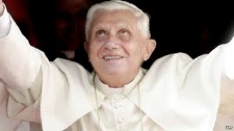
But history took its toll on the Pantheon, and in the seventeenth century, they saw that three columns in the portico were cracked. Pope Urban VIII of the Barbarini family, decided to restore them. When the scaffolding was put on, he saw to his astonishment that the roof and beams of the portico were also made of bronze. The visionary pope did not hesitate very long and ordered to replace them by wooden beams and terracotta tiles. The bronze was melted and used for making 80 canons for his defense in the Angel Castle, the rest was given to Bernini. He used it for making the 11 floors high canapé in the Saint Peter’s Basilica. The outrage of the Romans was sharp: the talking statue Pasquino was furious and next day they would find the following text: “Quod non fecerunt Barbari, fecerunt Barbarini” - “What the Barberians had not done, did the family Barbarini”, i.e. taking a way the last bronze of the Pantheon.
In the nineteenth century, the Pantheon underwent it last profound alteration. In the axe, on the left and the right of the Pantheon got buried the first kings of the united Italy. Often you still can see monarchist nobles who are guarding the tomb, maybe with the nostalgic dream that the monarchy once will return. On the one side we have Vittorio Emanule II, the other side (on the left of Raphael’s tomb) his son Umberto I, with his wife Queen Margherita di Savoia. As much I have read about her life, she must have been quite dull (nonetheless her residence in Rome was very nice: Palazzo Boncompagni, today the American Embassy). Maybe she would never got famous through the history, if not the people of Naples create a pizza Margaritta in her honor: According to popular tradition, in 1889, 28 years after the unification of Italy, during a visit to Naples of Queen Margherita of Savoy, wife of King Umberto I, chef Raffaele Esposito of Pizzeria Brandi and his wife created a pizza resembling the colors of the Italian flag, red (tomato), white (mozzarella) and green (basil).
They named it after the Queen - Pizza Margherita. It made her famous for eternity!
Buon Appetito !!!!

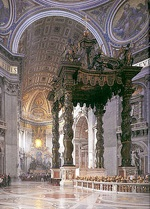
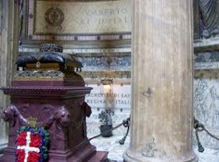


Thomas Jefferson memorial Washington D.C.
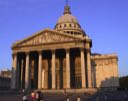
Pantheon, Paris
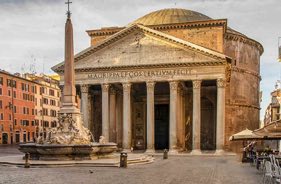
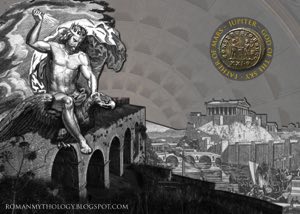

Ascension of Romulus to Heaven

